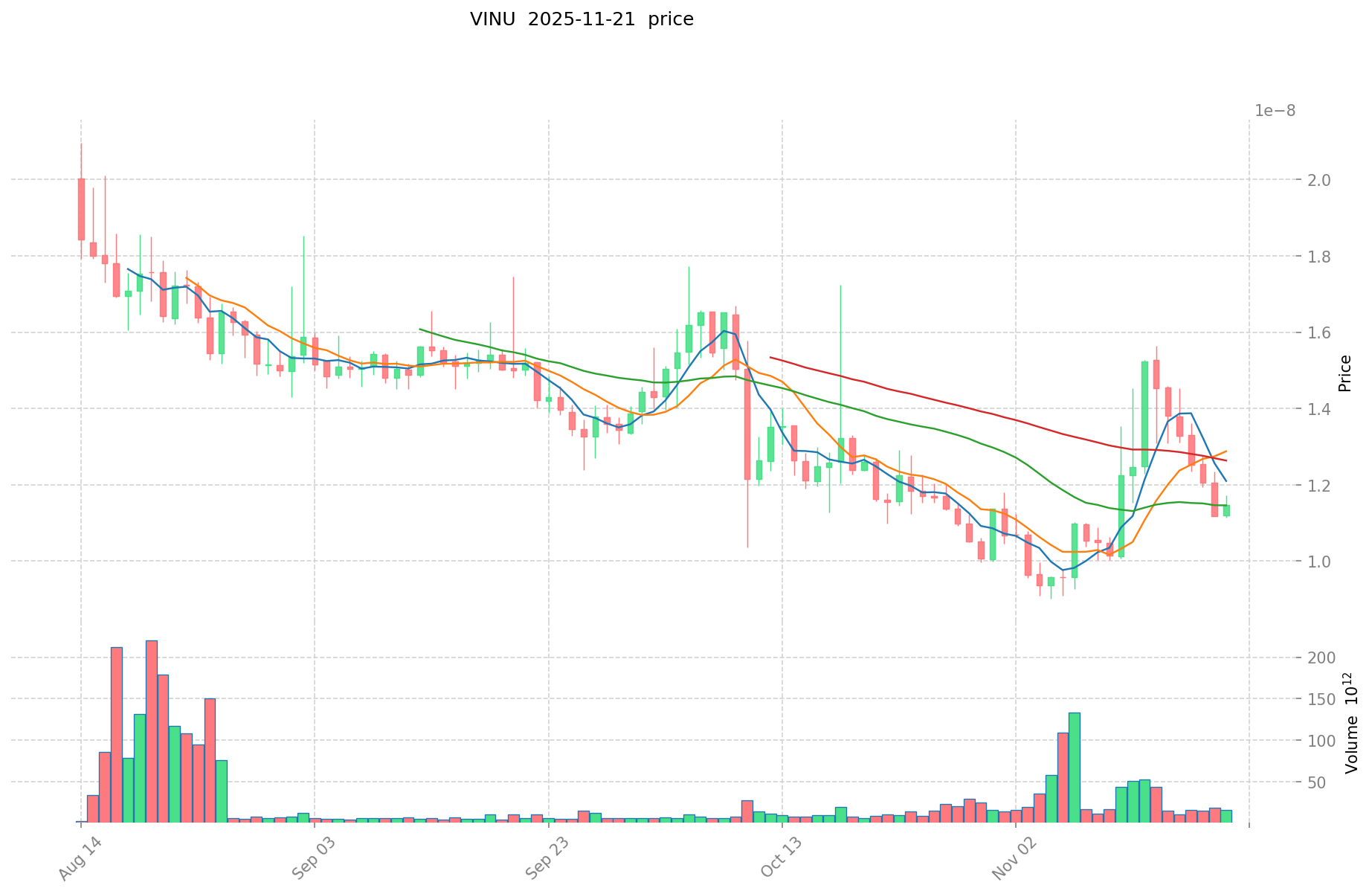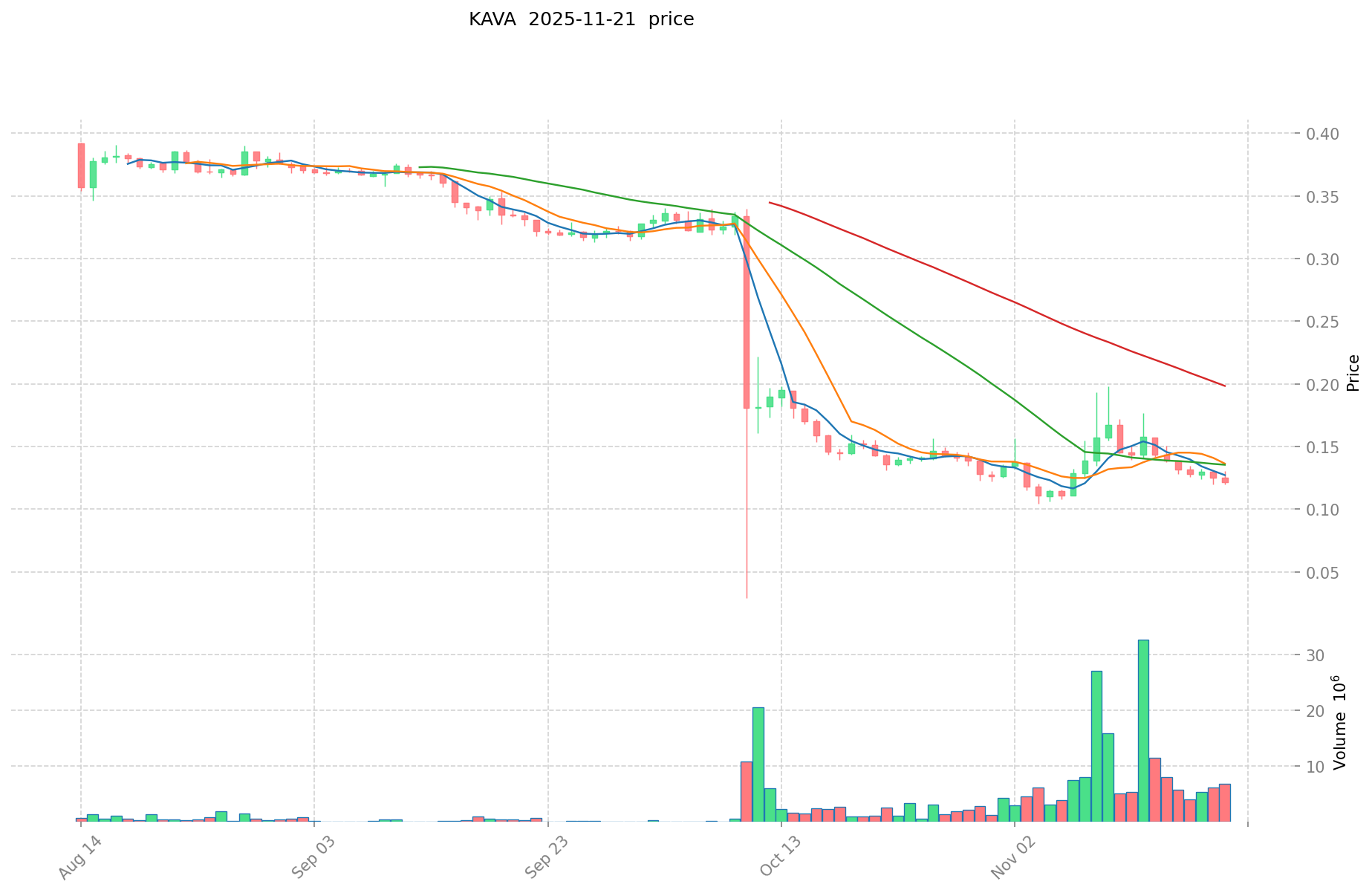VINU vs KAVA: A Comparative Analysis of Two Emerging Cryptocurrency Projects
Introduction: VINU vs KAVA Investment Comparison
In the cryptocurrency market, the comparison between Vita Inu (VINU) vs Kava (KAVA) has been an unavoidable topic for investors. The two not only show significant differences in market cap ranking, application scenarios, and price performance, but also represent different positioning in the crypto asset space.
Vita Inu (VINU): Since its launch, it has gained market recognition as a fast and feeless dog coin with high TPS and native smart contracts.
Kava (KAVA): Launched in 2019, it has been hailed as a cross-chain decentralized financial platform, providing mainstream digital asset collateralized loans and stablecoin services.
This article will comprehensively analyze the investment value comparison between VINU and KAVA, focusing on historical price trends, supply mechanisms, institutional adoption, technical ecosystems, and future predictions, attempting to answer the question investors care most about:
"Which is the better buy right now?"
I. Price History Comparison and Current Market Status
VINU and KAVA Historical Price Trends
- 2024: VINU reached its all-time high of $0.0000000738 on December 7, 2024.
- 2025: KAVA hit its all-time low of $0.105588 on November 5, 2025.
- Comparative analysis: In the recent market cycle, VINU dropped from its peak of $0.0000000738 to its current price of $0.000000011374, while KAVA fell from its all-time high of $9.12 to the current $0.11895.
Current Market Situation (2025-11-21)
- VINU current price: $0.000000011374
- KAVA current price: $0.11895
- 24-hour trading volume: VINU $181,637.35 vs KAVA $848,070.86
- Market Sentiment Index (Fear & Greed Index): 14 (Extreme Fear)
Click to view real-time prices:
- Check VINU current price Market Price
- Check KAVA current price Market Price


II. Core Factors Affecting Investment Value of VINU vs KAVA
Supply Mechanism Comparison (Tokenomics)
- VINU: VINU has a maximum supply of 1 quadrillion tokens, with 50% of the initial supply distributed via airdrops to the community.
- KAVA: KAVA has a total supply of 382 million tokens with an inflationary model where new tokens are minted as rewards for staking and participation.
- 📌 Historical Pattern: KAVA's controlled inflation aims to incentivize network participation while maintaining value, whereas VINU's large but fixed maximum supply relies on increasing adoption and community growth.
Institutional Adoption and Market Applications
- Institutional Holdings: KAVA has attracted more institutional interest due to its focus on providing DeFi services to financial institutions and its cross-chain capabilities.
- Enterprise Adoption: KAVA is positioned in cross-border payments and settlements through its lending platform and integration with multiple blockchains. VINU focuses more on community-driven applications and meme-coin use cases.
- Regulatory Attitudes: Both tokens face varying regulatory approaches across jurisdictions, with KAVA's DeFi infrastructure receiving more regulatory scrutiny than VINU's community token model.
Technical Development and Ecosystem Building
- VINU Technical Upgrades: Built on the energy-efficient Vite DAG platform with fee-less transactions, focusing on adoption in gaming, tipping, and community rewards.
- KAVA Technical Development: Operates a Layer-1 blockchain with Cosmos SDK and Tendermint consensus, enabling cross-chain DeFi applications and connecting major blockchain ecosystems.
- Ecosystem Comparison: KAVA has a more developed DeFi ecosystem with lending, staking, and yield farming protocols. VINU is building its ecosystem around community applications, tipping services, and gaming integrations.
Macroeconomic and Market Cycles
- Inflation Performance: KAVA, with its yield-generating capabilities, may offer better protection against inflation through staking rewards.
- Macroeconomic Monetary Policy: Interest rate increases typically impact both tokens negatively, but KAVA's utility in the DeFi space may provide some insulation during tightening cycles.
- Geopolitical Factors: KAVA's cross-chain infrastructure could benefit from increased demand for decentralized financial services during periods of international uncertainty.
III. 2025-2030 Price Prediction: VINU vs KAVA
Short-term Prediction (2025)
- VINU: Conservative $0.00000000842564 - $0.000000011386 | Optimistic $0.0000000165097
- KAVA: Conservative $0.111972 - $0.1204 | Optimistic $0.133644
Mid-term Prediction (2027)
- VINU may enter a growth phase, with expected prices ranging from $0.000000011096909 to $0.000000019206189
- KAVA may enter a volatile phase, with expected prices ranging from $0.078880662 to $0.172368854
- Key drivers: Institutional investment, ETF developments, ecosystem growth
Long-term Prediction (2030)
- VINU: Base scenario $0.000000015431709 - $0.000000018154952 | Optimistic scenario $0.000000024872285
- KAVA: Base scenario $0.122348950742109 - $0.2005720503969 | Optimistic scenario $0.24068646047628
Disclaimer: The above predictions are based on historical data and market analysis. Cryptocurrency markets are highly volatile and subject to rapid changes. These forecasts should not be considered as financial advice. Always conduct your own research before making investment decisions.
VINU:
| 年份 | 预测最高价 | 预测平均价格 | 预测最低价 | 涨跌幅 |
|---|---|---|---|---|
| 2025 | 0.0000000165097 | 0.000000011386 | 0.00000000842564 | 0 |
| 2026 | 0.000000014505764 | 0.00000001394785 | 0.000000009066102 | 22 |
| 2027 | 0.000000019206189 | 0.000000014226807 | 0.000000011096909 | 25 |
| 2028 | 0.000000017217993 | 0.000000016716498 | 0.000000013373198 | 46 |
| 2029 | 0.00000001934266 | 0.000000016967245 | 0.000000014252486 | 49 |
| 2030 | 0.000000024872285 | 0.000000018154952 | 0.000000015431709 | 59 |
KAVA:
| 年份 | 预测最高价 | 预测平均价格 | 预测最低价 | 涨跌幅 |
|---|---|---|---|---|
| 2025 | 0.133644 | 0.1204 | 0.111972 | 0 |
| 2026 | 0.1651286 | 0.127022 | 0.11050914 | 6 |
| 2027 | 0.172368854 | 0.1460753 | 0.078880662 | 22 |
| 2028 | 0.16559096008 | 0.159222077 | 0.11941655775 | 33 |
| 2029 | 0.2387375822538 | 0.16240651854 | 0.1559102577984 | 35 |
| 2030 | 0.24068646047628 | 0.2005720503969 | 0.122348950742109 | 67 |
IV. Investment Strategy Comparison: VINU vs KAVA
Long-term vs Short-term Investment Strategy
- VINU: Suitable for investors focused on community-driven projects and meme coin potential
- KAVA: Suitable for investors interested in DeFi infrastructure and cross-chain capabilities
Risk Management and Asset Allocation
- Conservative investors: VINU: 10% vs KAVA: 90%
- Aggressive investors: VINU: 30% vs KAVA: 70%
- Hedging tools: Stablecoin allocation, options, cross-currency portfolio
V. Potential Risk Comparison
Market Risk
- VINU: High volatility due to meme coin status and community sentiment
- KAVA: Exposure to DeFi market fluctuations and cross-chain ecosystem risks
Technical Risk
- VINU: Scalability, network stability
- KAVA: Smart contract vulnerabilities, interoperability challenges
Regulatory Risk
- Global regulatory policies may impact both tokens differently, with KAVA potentially facing more scrutiny due to its DeFi focus
VI. Conclusion: Which Is the Better Buy?
📌 Investment Value Summary:
- VINU advantages: Fast and feeless transactions, strong community engagement, potential for viral growth
- KAVA advantages: Established DeFi ecosystem, cross-chain capabilities, institutional interest
✅ Investment Advice:
- New investors: Consider a small allocation to VINU for exposure to meme coin market, focus more on KAVA for its established ecosystem
- Experienced investors: Balanced approach with higher allocation to KAVA, use VINU for potential high-risk, high-reward opportunities
- Institutional investors: Focus on KAVA for its DeFi infrastructure and cross-chain capabilities
⚠️ Risk Warning: The cryptocurrency market is highly volatile, and this article does not constitute investment advice. None
VII. FAQ
Q1: What are the main differences between VINU and KAVA? A: VINU is a fast, feeless meme coin focused on community-driven applications, while KAVA is a cross-chain DeFi platform offering lending and stablecoin services. VINU has a fixed maximum supply of 1 quadrillion tokens, whereas KAVA has an inflationary model with a total supply of 382 million tokens.
Q2: Which token has shown better price performance recently? A: Based on the current market data, KAVA has shown better price stability compared to VINU. KAVA is trading at $0.11895, while VINU is at $0.000000011374. However, both have experienced significant drops from their all-time highs.
Q3: How do the ecosystems of VINU and KAVA compare? A: KAVA has a more developed DeFi ecosystem with lending, staking, and yield farming protocols. VINU is building its ecosystem around community applications, tipping services, and gaming integrations.
Q4: Which token is more suitable for institutional investors? A: KAVA is generally more suitable for institutional investors due to its focus on providing DeFi services to financial institutions and its cross-chain capabilities. It has attracted more institutional interest compared to VINU.
Q5: What are the long-term price predictions for VINU and KAVA? A: By 2030, VINU is predicted to reach between $0.000000015431709 and $0.000000024872285, while KAVA is expected to be between $0.122348950742109 and $0.24068646047628. However, these predictions are subject to market volatility and should not be considered financial advice.
Q6: How should investors allocate their portfolio between VINU and KAVA? A: Conservative investors might consider allocating 10% to VINU and 90% to KAVA, while more aggressive investors could opt for 30% VINU and 70% KAVA. The exact allocation should depend on individual risk tolerance and investment goals.
Q7: What are the main risks associated with investing in VINU and KAVA? A: VINU faces high volatility due to its meme coin status and potential scalability issues. KAVA is exposed to DeFi market fluctuations, smart contract vulnerabilities, and potential regulatory scrutiny. Both are subject to general cryptocurrency market risks.
Share
Content